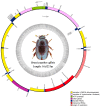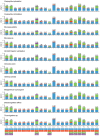The First Two Complete Mitochondrial Genomes for the Subfamily Meligethinae (Coleoptera: Nitidulidae) and Implications for the Higher Phylogeny of Nitidulidae
- PMID: 38249063
- PMCID: PMC10816600
- DOI: 10.3390/insects15010057
The First Two Complete Mitochondrial Genomes for the Subfamily Meligethinae (Coleoptera: Nitidulidae) and Implications for the Higher Phylogeny of Nitidulidae
Abstract
The phylogenetic status of the family Nitidulidae and its sister group relationship remain controversial. Also, the status of the subfamily Meligethinae is not fully understood, and previous studies have been mainly based on morphology, molecular fragments, and biological habits, rather than the analysis of the complete mitochondrial genome. Up to now, there has been no complete mitochondrial genome report of Meligethinae. In this study, the complete mitochondrial genomes of Meligethinus tschungseni and Brassicogethes affinis (both from China) were provided, and they were compared with the existing complete mitochondrial genomes of Nitidulidae. The phylogenetic analysis among 20 species of Coleoptera was reconstructed via PhyloBayes analysis and Maximum likelihood (ML) analysis, respectively. The results showed that the full lengths of Meligethinus tschungseni and Brassicogethes affinis were 15,783 bp and 16,622 bp, and the AT contents were 77% and 76.7%, respectively. Each complete mitochondrial genome contains 13 protein-coding genes (PCGs), 22 transfer RNA genes (tRNAs), 2 ribosomal RNA genes (rRNAs), and a control region (A + T-rich region). All the PCGs begin with the standard start codon ATN (ATA, ATT, ATG, ATC). All the PCGs terminate with a complete terminal codon, TAA or TAG, except cox1, cox2, nad4, and nad5, which terminate with a single T. Furthermore, all the tRNAs have a typical clover-leaf secondary structure except trnS1, whose DHU arm is missing in both species. The two newly sequenced species have different numbers and lengths of tandem repeat regions in their control regions. Based on the genetic distance and Ka/Ks analysis, nad6 showed a higher variability and faster evolutionary rate. Based on the available complete mitochondrial genomes, the results showed that the four subfamilies (Nitidulinae, Meligethinae, Carpophilinae, Epuraeinae) of Nitidulidae formed a monophyletic group and further supported the sister group relationship of Nitidulidae + Kateretidae. In addition, the taxonomic status of Meligethinae and the sister group relationship between Meligethinae and Nitidulinae (the latter as currently circumscribed) were also preliminarily explored.
Keywords: barcode gene; evolution rate; identification; pollen beetle; species-specific markers.
Conflict of interest statement
The authors declare no conflicts of interest.
Figures










References
-
- Lee M.H., Lee S., Leschen R.A.B., Lee S. Evolution of feeding habits of sap beetles (Coleoptera: Nitidulidae) and placement of Calonecrinae. Syst. Entomol. 2020;45:911–923. doi: 10.1111/syen.12441. - DOI
-
- Robertson J.A., Ślipiński A., Moulton M., Shockley F.W., Giorgi A., Lord N.P., Mckenna D.D., Tomaszewska W., Forrester J., Miller K.B. Phylogeny and classification of Cucujoidea and the recognition of a new superfamily Coccinelloidea (Coleoptera: Cucujiformia) Syst. Entomol. 2015;40:745–778. doi: 10.1111/syen.12138. - DOI
-
- Audisio P. Fauna d’Italia 32. Coleoptera, Nitidulidae–Kateridae. Volume 32. Edizioni Calderini; Roma, Italy: 1993. p. 971.
-
- Audisio P., Cline A.R., De Biase A., Antonini G., Mancini E., Trizzino M., Costantini L., Strika S., Lamanna F., Cerretti P. Preliminary re-examination of genus-level taxonomy of the pollen beetle subfamily Meligethinae (Coleoptera: Nitidulidae) Acta Entomol. Musei Natl. Pragae. 2009;49:341–504.
Grants and funding
LinkOut - more resources
Full Text Sources
Research Materials

